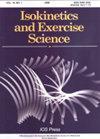张力疲劳方案对等长和等速性能的影响
IF 0.6
4区 医学
Q4 ENGINEERING, BIOMEDICAL
引用次数: 0
摘要
目的:根据Thorstensson和Karlsson(1976)的介绍,让参与者进行50次最大等速收缩,是迄今为止最常用的疲劳方案之一。目的:确定Thorstensson疲劳方案在多大程度上影响等速和等长性能特征。方法:25名大学年龄的男性进行等速疲劳方案,包括以中等速度(180∘∙s-1)进行50次最大肘部弯曲。试验前和试验后用于计算以下变量的疲劳指数(FI%):等轴测和等速峰值扭矩(PT)、等轴测扭矩发展率(RTD)和最大加速度(ACCmax)。结果:四个因变量中的每一个都随着疲劳而显著降低(均表现出p<0.001),但幅度不相同。等距PT FI(-18.7%)显著低于等速PT FI(-45.1%,p⩽0.001在RTD FI%和ACCmax FI%之间观察到,也在等速PT FI%和ACC最大FI%之间观测到。结论:本研究观察到,在等速疲劳方案下,等长和等速评估在最大强度方面的反应模式不同。此外,在等长评估和动态评估之间,快速产生强度和速度的能力对疲劳的反应显著不同。由于这些不同的反应,我们建议疲劳评估至少包括与疲劳协议模式相同的测试模式。本文章由计算机程序翻译,如有差异,请以英文原文为准。
Effects of a thorstensson fatiguing protocol on isometric and isokinetic performance
OBJECTIVE: Having participants perform 50 maximal isokinetic contractions, as introduced by Thorstensson and Karlsson (1976), is to this day one of the most commonly used fatigue protocols. Purpose: To determine to what extent a Thorstensson fatiguing protocol affects isokinetic and isometric performance characteristics. METHODS: Twenty-five college-aged men performed an isokinetic fatigue protocol consisting of 50 maximal elbow flexions at a moderate speed (180∘⋅s-1). Pre- and post-tests were used to calculate fatigue indices (FI%) for the following variables: isometric and isokinetic peak torque (PT), isometric rate of torque development (RTD), and maximum acceleration (ACCmax). RESULTS: Each of the four dependent variables significantly decreased with fatigue (each demonstrated p< 0.001), but not of the same magnitude. Isometric PT FI (-18.7%) was significantly less than isokinetic PT FI (-45.1%, p⩽ 0.001) and ACCmax FI (-26.3%) was significantly less than isometric RTD FI (-54.9%, p⩽ 0.001). There was a significant positive relationship between isometric and isokinetic PT FI% (r= 0.60, p< 0.002) as well as between isometric PT FI% and RTD FI% (r= 0.40, p< 0.046). There was no significant relationship observed between RTD FI% and ACCmax FI% nor between isokinetic PT FI% and ACCmax FI%. CONCLUSIONS: This investigation observed different patterns of response in maximal strength between isometric and isokinetic assessments following a isokinetic fatigue protocol. Additionally, the ability to rapidly generate strength and velocity had significantly different responses to fatigue between isometric and dynamic assessments. Due to these different responses, we recommend that assessments of fatigue at least include the same testing modality as the modality of the fatigue protocol.
求助全文
通过发布文献求助,成功后即可免费获取论文全文。
去求助
来源期刊

Isokinetics and Exercise Science
医学-工程:生物医学
CiteScore
1.20
自引率
14.30%
发文量
37
审稿时长
>12 weeks
期刊介绍:
Isokinetics and Exercise Science (IES) is an international journal devoted to the study of theoretical and applied aspects of human muscle performance. Since isokinetic dynamometry constitutes the major tool in this area, the journal takes a particular interest in exploring the considerable potential of this technology.
IES publishes studies associated with the methodology of muscle performance especially with respect to the issues of reproducibility and validity of testing, description of normal and pathological mechanical parameters which are derivable from muscle testing, applications in basic research topics such as motor learning paradigms and electromyography. The journal also publishes studies on applications in clinical settings and technical aspects of the various measurement systems employed in human muscle performance research.
The journal welcomes submissions in the form of research papers, reviews, case studies and technical reports from professionals in the fields of sports medicine, orthopaedic and neurological rehabilitation and exercise physiology.
 求助内容:
求助内容: 应助结果提醒方式:
应助结果提醒方式:


